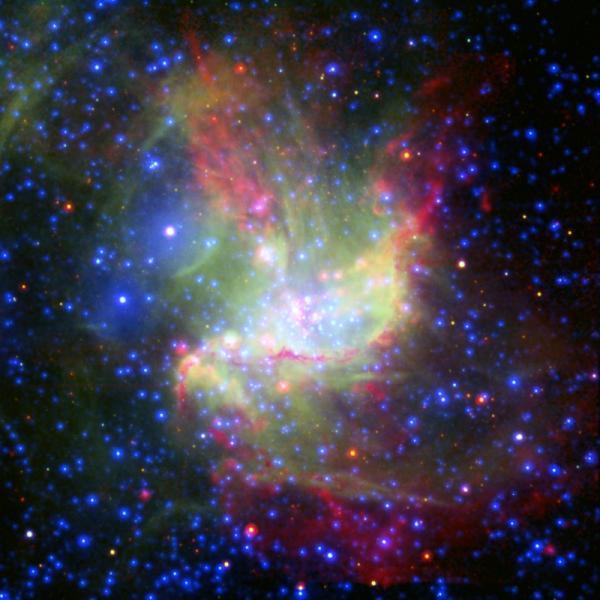Stars formed from the wind
The terrestrial and space telescope combined to capture a picture that provides a new perspective on the history of a highly concentrated area, NGC 346. This new image, with different wavelengths of phase mix like watercolors, revealing new information about star formation.
The combined image of infrared, visible light and X-rays from NASA's Spitzer Space Telescope, New Technology Telescope (NTT) of ESO and XMM-Newton, Space Agency's X-ray telescope Europe. NTT's visible light image allows astronomers to reveal brilliant gas clouds in space and multi-wavelength images that bring new insights, thanks to the combination of the aforementioned information.
NGC 346 is the most star-forming region in the Small Magellanic Cloud, an exotic dwarf galaxy that centers around the Milky Way at a distance of 210 000 light-years.
Dimitrios Gouliermis of Max Planck Astronomy Academy in Heidelberg, Germany, said: 'NGC 346 is an astronomical' zoo '. When combining information from different wavelengths, we can find out what's happening in different parts of this interesting space. '
Small stars are scattered throughout NGC 346, while large stars are concentrated mainly in the center. Large stars and most small stars form at the same time from a dense cloud, while moderate stars are formed later through a process of 'star formation'. Strong radiation from large stars burns the surrounding parts of dust clouds, stimulating gas to inflate and creating pulses that compress nearby ice dust and gas into new stars. Orange-red fibers surround the central part of the photo where this process occurs

The new image of the stellar region forms NGC 346, with different wavelengths blending like a watercolor painting, revealing new information about star formation.NGC 346 is 210 000 light-years away in the small Magellanic Cloud, dwarf galaxy adjacent to the Milky Way.The photo is based on data from ESA XMM-Newton (X-ray, blue), ESO's new technology telescope (he saw bright, green), and Spitzer of NASA (infrared, red) .Infrared rays display ice dust, while visible light shows the glowing gas, and X-rays represent very hot gases.Normal stars appear as blue dots with white cores, while young stars are covered in dust and appear as red dots with white cores.(Photo: ESO / ESA / JPL-Caltech / NASA / D. Gouliermis (MPIA) et al.)
However, a younger group of stars has a small mass in this area, the pink spots at the top of the image, cannot be explained by this mechanism. Gouliermis said: 'We are particularly interested in the isolation process of these stars'.
By combining multi-wavelength data on NGC 346, Gouilermis and his team were able to determine the stimulus that is a massive star crumbling in a supernova explosion about 50,000 years ago . Strong winds, not radiation, pushed air and dust together, compressing them into new stars, forming isolated young star clusters. While the remainder of the large star is not shown in the picture, a bright bubble is created when the star explodes so as to be close to a large white spot surrounded by a blue halo. on the left (white light spot is actually a collection of 3 stars).
This finding demonstrates that both wind and radiation stimulate star formation in the same cloud. According to Gouliermis, 'the results show us that star formation is a more complex process than we thought, including competing and integrated mechanisms'.
This research was completed thanks to the combination of information gathered from different technologies and equipment. It represents the power of a combination of space and space observatories.
- First recorded the 'eating' planet image around the young star
- Discovered that twin stars are being incubated in a physical disk
- The formation of 'dark stars' in the universe
- Discover the oldest stars in the universe?
- 10 things not everyone knows about the wind
- Why does the wind look stronger than usual when standing near tall buildings?
- Discover a planet forming around two stars
- What happens if the wind stops blowing on Earth?
- The formation of young star generations
- 9 interesting things about stars
- Discovering the 'twin brothers' of the Sun, the prospect of the second Earth is no longer far away?
- Lam Dong develops wind power
 Van Allen's belt and evidence that the Apollo 11 mission to the Moon was myth
Van Allen's belt and evidence that the Apollo 11 mission to the Moon was myth The levels of civilization in the universe (Kardashev scale)
The levels of civilization in the universe (Kardashev scale) Today Mars, the sun and the Earth are aligned
Today Mars, the sun and the Earth are aligned The Amazon owner announced a secret plan to build a space base for thousands of people
The Amazon owner announced a secret plan to build a space base for thousands of people